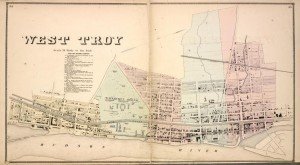
On May 10, 1862, as the nation was consumed by the ravages of the Civil War, Troy NY faced a devastating fire. As a train crossed the Hudson River on the Troy-Green Island Bridge, a spark from the engine ignited the wooden bridge. The fire spread rapidly, ultimately destroying over 600 buildings in the heart of the city in only six hours. Newspaper accounts, personal letters and even artist renderings depict a city in chaos as people struggled to save their homes and businesses. The Rensselaer County Historical Society (RCHS) has opened a new exhibit commemorating the 150th anniversary of Troy’s Great Fire. The exhibit runs through August 18, 2012.
Stacy Pomeroy Draper, RCHS Curator, said, “The Great Fire is one of Troy’s most significant events as it dynamically altered the look of the city. As many local towns learned after the hurricane and tropical storms of last year, natural disaster can dramatically change a location in the blink of an eye. The story of Troy’s rise after the fire is one that can inspire us today to rebuild after a tragedy.”
Advances in fire fighting technology, such as the use of steam-powered fire engines were applauded for their role in saving the city, and citizens joined together to re-emerge from the catastrophe. Well known architects designed new buildings in the latest styles and new building codes were introduced mandating the use of fire resistant building materials.
The exhibit focuses on four main themes- Troy in the 1860s, Mid-19th Century fire fighting techniques, the event itself known as The Great Fire of May 10, 1862 and the aftermath, including personal impacts, changes to city code and fire safety. A number of early photographic images, several recently discovered, show the city just before the fire and document the devastation.
Artifacts on display include firefighting equipment such as fire buckets, a rare fireman’s jacket and helmets. Accounts of the event from local newspapers and eyewitness descriptions found in personal letters, several of which came to light as research was undertaken, tell the story firsthand. A number of fire related artifacts from public institutions and private lenders will also be on display for the first time, including a toy steam fire engine from the FASNY Museum of Firefighting in Hudson, New York.
Programming during the exhibit will include a trip to see the extensive fire collections at the FASNY Museum of Firefighting. RCHS will lead a walking tour of the district impacted by the fire on Saturday, May 12 at 10:30am. The tour departs from the Market Table at the Troy Waterfront Farmers’ Market. Tour is $5 per person, free for RCHS members.
Stacy Pomeroy Draper, RCHS curator, is available to give illustrated lectures about the fire.
The exhibit is sponsored in part by B-Lann Equipment Co., John G Waite Associates and the Troy Uniformed Firefighters Association.
Illustration: Grandma Moses, “The Burning of Troy in 1862″- (1943)
 The Rensselaer County Historical Society (RCHS) has announced the 2013 Thomas Phelan Endowed Lecture. Franklin Vagnone, Executive Director of the Historic House Trust of New York City, will present an illustrated lecture titled, “The Anarchist Guide to Historic House Museums”. The lecture will be held at 10:00am on Saturday June 22 at Bush Memorial Hall on the Russell Sage College campus. The lecture is free and open to the public.
The Rensselaer County Historical Society (RCHS) has announced the 2013 Thomas Phelan Endowed Lecture. Franklin Vagnone, Executive Director of the Historic House Trust of New York City, will present an illustrated lecture titled, “The Anarchist Guide to Historic House Museums”. The lecture will be held at 10:00am on Saturday June 22 at Bush Memorial Hall on the Russell Sage College campus. The lecture is free and open to the public.






